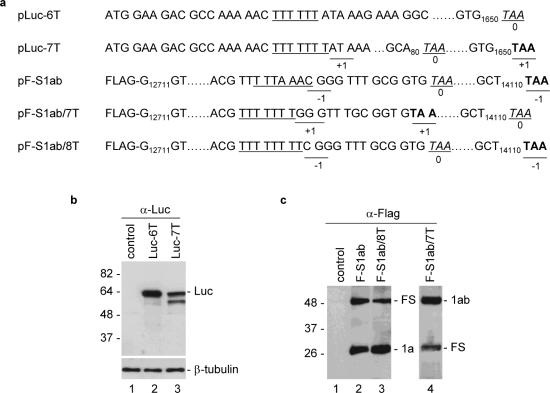Figure 4.
Analysis of frameshifting efficiencies mediated by hepta- and octo-uridine stretches in heterogeneous ORFs. (a) Diagram showing the structures of constructs pLuc-6T, pLuc-7T, pF-S1ab, pF-S1ab/7T and pF-S1ab/8T. The slippery sequences (the six T stretch in the case of pLuc-6T) is underlined, the TAA termination codon for 0 frame is italic and underlined, and the TAA termination codon for +1 or −1 frame is underlined and in bold. (b) Expression of pLuc-6T and pLuc-7T in Cos-7 cells. Cells were infected with the recombinant vaccinia/T7 virus, and transfected with an empty control plasmid (lane 1), pLuc-6T (lane 2) and pLuc-7T (lane 3). At 18 h posttransfection, cells were harvested and lysates prepared. Polypeptides were separated on SDS–12% polyacrylamide and analyzed by western blot with anti-luciferase antibodies. Bands corresponding to the full-length luciferase and -β-tubulin are indicated. Numbers on the left indicate molecular masses in kilodaltons. (c) Expression of pF-S1ab, pF-S1ab/7T and pF-S1ab/8T in Cos-7 cells. Cells were infected with the recombinant vaccinia/T7 virus, and transfected with an empty control plasmid (lane 1), pF-S1ab (lane 2), pF-S1ab/7T (lane 3) and pF-S1ab/8T (lane 4). At 18 h posttransfection, cells were harvested and lysates prepared. Polypeptides were separated on SDS–12% polyacrylamide and analyzed by western blot with anti-Flag antibodies. Bands corresponding to 1a (or 1ab) and the frameshifting products are indicated. Numbers on the left indicate molecular masses in kilodaltons.

